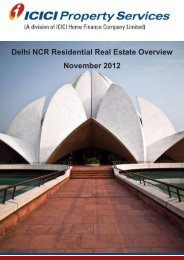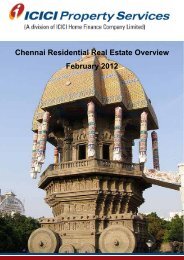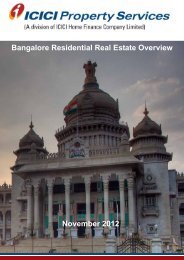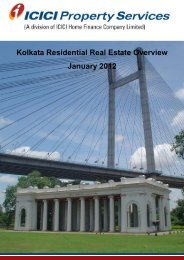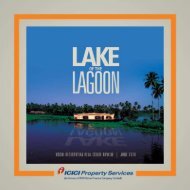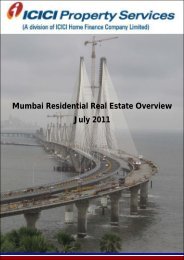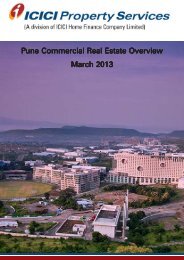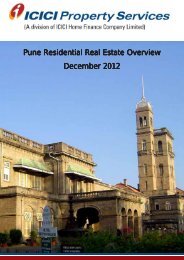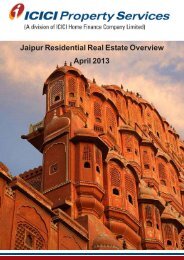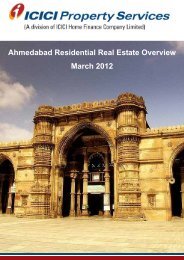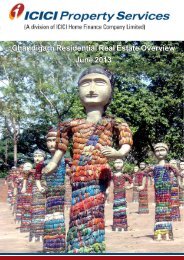Lucknow Residential Real Estate Overview July 2012 - ICICI Home ...
Lucknow Residential Real Estate Overview July 2012 - ICICI Home ...
Lucknow Residential Real Estate Overview July 2012 - ICICI Home ...
You also want an ePaper? Increase the reach of your titles
YUMPU automatically turns print PDFs into web optimized ePapers that Google loves.
<strong>Lucknow</strong> <strong>Residential</strong> <strong>Real</strong> <strong>Estate</strong> <strong>Overview</strong><br />
<strong>July</strong> <strong>2012</strong>
TABLE OF CONTENTS<br />
1. Executive Summary 3<br />
2. <strong>Lucknow</strong> Fact File 4<br />
3. <strong>Lucknow</strong> <strong>Real</strong> <strong>Estate</strong> 7<br />
4. Micro Trends 10<br />
5. Trans-Gomti Region - Zone 1 11<br />
6. Trans-Gomti Region - Zone 2 13<br />
7. Cis Gomti Region - Zone 3 15<br />
8. Central <strong>Lucknow</strong> 17<br />
9. Cis Gomti Region - Zone 5 19<br />
10. Location Attractiveness Index 20<br />
11. Disclaimer 21<br />
2
EXECUTIVE SUMMARY<br />
The <strong>Lucknow</strong> <strong>Residential</strong> <strong>Real</strong> <strong>Estate</strong> <strong>Overview</strong>, <strong>July</strong> <strong>2012</strong>, offers a comprehensive insight into the key macro and<br />
micro trends evolving in the <strong>Lucknow</strong> residential realty markets. The <strong>ICICI</strong> <strong>Home</strong> Finance Company Research team<br />
undertook a detailed city survey and elucidated below are the key findings of the report.<br />
• On the basis of geographical location and development history, the report has broadly classified the city into two<br />
parts, Old <strong>Lucknow</strong> and New <strong>Lucknow</strong>. Old <strong>Lucknow</strong> was established during the 'Nawab' era and is typically<br />
dotted with old-cramped developments. However, New <strong>Lucknow</strong> which has emerged only a few decades ago, is<br />
replete with planned development and adequate social infrastructure. New <strong>Lucknow</strong> demonstrates high real<br />
estate potential and has been the focal point of our study.<br />
• <strong>Lucknow</strong> real estate market is currently a buyer's market and is largely driven by end users. Our estimates<br />
suggest 40% investor participation in New <strong>Lucknow</strong> and we anticipate some rise in these numbers in the future.<br />
• The market is primarily driven by bureaucrats, politicians, public/government servants, some private sector<br />
employees and original inhabitants of <strong>Lucknow</strong> who have now migrated outside, yet wish to have a base in<br />
<strong>Lucknow</strong>. Huge demand also flows in from surrounding cities on account of aspirations to enjoy better amenities<br />
and opportunities amiss in other cities of Uttar Pradesh.<br />
• <strong>Lucknow</strong> real estate markets have been stable with a slight upward bias. During the FY 2011-12 average price<br />
appreciation in certain locations has been in the range of 8 - 15%.<br />
• A recent CRISIL report titled '<strong>Real</strong>(i)ty Next-Beyond the top 10 cities of India’, stated that <strong>Lucknow</strong> is one of the<br />
next top ten cities with enormous real estate potential. The builders exude positive market sentiment in the long<br />
run, which is supported by the fact that many outside developers of repute have expressed interest in establishing<br />
their projects in the city.<br />
• The city's radial expansion has given way to new growth corridors on the real estate development map, especially<br />
along the highways that connect with neighboring cities such as Kanpur, Rae Bareli, Hardoi, Sitapur, Faizabad<br />
and Sultanpur. The real estate markets along these regions have recently witnessed some traction and many<br />
known developers have launched their projects along these locations. Moreover, focus on the supporting<br />
infrastructural development is also gaining ground.<br />
• While locations in Central <strong>Lucknow</strong> such as Mall Avenue and Jopling Road are old prime zones offering properties<br />
in the range of INR 3,500 - 6,500/sft., Gomtinagar and its extensions are new niche locations with properties in the<br />
price bracket of INR 2,000 - 4,000/sft. on offer. Many good projects by known developers spread across Gomtinagar,<br />
Rae Bareli Road, Sultanpur Road, Faizabad Road, Hardoi Road and Jankipuram have evoked a good response<br />
in the market.<br />
• The recent political change has brought a sense of optimism amongst market players. With the revival of LIDA<br />
(<strong>Lucknow</strong> Industrial Development Authority), there are plans to focus on Industrial and IT growth in the city. Such<br />
developments, once materialized, will provide the much needed impetus to the market demand.<br />
• <strong>Lucknow</strong> being the state capital, has emerged as a key center of business and financial activities for entire Uttar<br />
Pradesh. Government offices and BFSI sector are key segments which have witnessed growth in the city. Moreover,<br />
the Telecom sector has also emerged as a user of space in the city. MG Road (Mahatma Gandhi Road) at<br />
Hazratganj is the Central Business District (CBD) housing the main government and BFSI sector offices. Gomtinagar<br />
zone (esp. Vibhuti Khand and Vipin Khand) is emerging as a Secondary Business District (SBD). Faizabad Road,<br />
Mahanagar and Aliganj also witnessed some amount of commercial activity.<br />
• The organised retail market activity has paced-up in the city, especially in the last 4-5 years. While MG Road and<br />
Hazratganj are the most prominent shopping high-streets in <strong>Lucknow</strong>, Aminabad and Chowk are typical old retail<br />
destinations famous for 'Chikankari' works of small-scale industries. Moreover, Mahanagar, Indiranagar and<br />
Gomtinagar also have shopping arcades in various pockets. Organized retail is booming in the city and a number<br />
of malls (located in Hazratganj, Gomtinagar and Alambagh) have obtained a decent response. Sahara mall<br />
(Hazratganj), East End mall, Zee mall, Riverside mall (Gomtinagar) and Phoenix United mall (Alambagh) are<br />
operational malls witnessing decent foot-falls.<br />
3
LUCKNOW FACT FILE<br />
City <strong>Overview</strong><br />
<strong>Lucknow</strong> Metropolis, the state capital of Uttar Pradesh, traditionally known for its rich cultural heritage and distinct<br />
etiquette is now emerging as one of the fastest growing non-metropolitan cities. Shedding its old image of a city famous<br />
only for its unique styles of embroidery like 'Chikan' and 'Lakhnawi Zardozi', it is today a centre of modern technology,<br />
with a high level of investment, institutional development and progressive outlook. It is witnessing an economic boom<br />
which is reflected in the pace of real estate development in the city. Today, <strong>Lucknow</strong> is an amalgamation of cultured<br />
grace and newly acquired pace.<br />
Geographical Location<br />
The city is geographically located at 26.5 0 N and 80.5 0 E in the Northern Gangetic plains, around 123 metres above sea<br />
level. The present metropolitan area of <strong>Lucknow</strong> is envisaged to be 3091.40 sq km. The River Gomti flows through the<br />
city, dividing the whole city diagonally into trans-Gomti and cis-Gomti regions. Some of the tributaries of this river are<br />
the Kukrail, Loni and Beta. The Sai river flows from the south of the city. <strong>Lucknow</strong> witnesses diverse climatic conditions,<br />
with hot-humid summers from April to June (maximum temperature 47 0 C) and cool-dry winters from December to<br />
February (minimum temperature 20 0 C).<br />
Surrounding Towns and Cities<br />
The city is surrounded by towns and villages like Malihabad, Kakori, Mohanlalganj, Gosainganj, Chinhat and Itaunja. It<br />
is bounded by the Barabanki district in the east and the Sitapur district in the north. To the north west of the city is Hardoi<br />
district, while south-east and south-west are bounded by Rae Bareli and Unnao districts respectively.<br />
Economy and Demographics<br />
As per the provisional census 2011, the population of <strong>Lucknow</strong><br />
has seen a decadal growth of 25.79% and currently stands at<br />
4,588,455. This includes 2,407,897 males and 2,180,558 females.<br />
The district has a literacy rate of 79.33 %; male and female literacy<br />
are at 84.27% and 73.33% respectively. The sex ratio of <strong>Lucknow</strong><br />
has witnessed an increase of 2.03% over the decade and currently<br />
stands at 906 females per 1000 males. The service sector forms<br />
the main economic base of the city. Government departments<br />
and the public sector undertakings are the principal employers of<br />
the salaried middle-class. Liberalisation has created many more<br />
opportunities and the service sector and self-employed<br />
professionals are burgeoning in the city.<br />
Census 2011 Key Highlights<br />
Description 2011 2001<br />
Actual Population 4,588,455 3,647,834<br />
Male 2,407,897 1,932,317<br />
Female 2,180,558 1,715,517<br />
Population Growth 25.79% 32.03%<br />
Area Square Km. 2,528 2,528<br />
Density/Square Km. 1,815 1,443<br />
Sex Ratio (females per 1000 males) 906 888<br />
Average Literacy Rate 79% 69%<br />
Male Literacy Rate 84% 76%<br />
Female Literacy Rate 74% 60%<br />
Source: Census 2011<br />
History<br />
<strong>Lucknow</strong> traces its origin to the Suryavanshi dynasty of Ayodhya in ancient times and derives its name from Lakshman,<br />
brother of Lord Rama, the hero of the Indian epic 'Ramayana'. The city came into eminence only during the 18th<br />
century. In 1732, Mohammad Shah, one of the later kings of the once powerful Mughal dynasty, appointed Mohammad<br />
Amir Saadat Khan, a Persian adventurer of noble lineage, to the vice royalty of the area known as Awadh, of which<br />
<strong>Lucknow</strong> was a part.<br />
At the time of the first war of independence in 1857, the city suffered a lot of damages, vestiges of which are still evident<br />
in the dilapidated buildings. The old past was replaced with new developments during the British period. Post<br />
independence, <strong>Lucknow</strong> replaced Allahabad as the capital of Uttar Pradesh.<br />
4
LUCKNOW FACT FILE<br />
Administrative Framework<br />
<strong>Lucknow</strong> is the political and administrative capital of Uttar Pradesh. The city elects members to the Lok Sabha as well<br />
as the Uttar Pradesh Vidhan Sabha (State Assembly). <strong>Lucknow</strong> has two Lok Sabha constituencies named <strong>Lucknow</strong><br />
and Mohanlalganj.<br />
The city is under the jurisdiction of a District Magistrate/Collector, who is an IAS officer. The Collector is in charge of<br />
property records and revenue collection for the Government. The Collector oversees the national elections held in the<br />
city and is also responsible for maintaining law and order.<br />
The civic amenities of the city are managed by the <strong>Lucknow</strong> Municipal Corporation with executive power vested in the<br />
Municipal Commissioner. The Corporation comprises elected members (corporators elected from the wards directly<br />
by the people) with the City Mayor as its head. An Assistant Municipal Commissioner oversees each ward for<br />
administrative purposes.<br />
Existing and Upcoming Infrastructure<br />
<strong>Lucknow</strong> has experienced immense infrastructural development in the past two decades. The development has acquired<br />
pace during the last decade in terms of organised and planned development of roadways, entertainment zones, good<br />
educational institutions and other public amenities. Recently the city's central commercial hub, Hazratganj has undergone<br />
a makeover which gives it a near international look.<br />
While New <strong>Lucknow</strong>, the part of the city that started to develop at a much later stage, has good infrastructural facilities<br />
such as well-planned road networks, water and sanitation facilities, presence of organized retail and other social<br />
amenities, the Old <strong>Lucknow</strong> region, that constitutes the older parts of the city established during the 'Nawab' era,<br />
suffers from unsatisfactory basic facilities. <strong>Lucknow</strong> being an eligible city in JNNURM (Jawaharlal Nehru National<br />
Urban Renewal Mission) is expected to witness improved infrastructure in the future.<br />
Road Connectivity<br />
There are four national highways and four state highways in the city:<br />
National Highways<br />
NH 24 connects Delhi<br />
NH 25 connects Bhopal via Jhansi<br />
NH 28 connects to Makama (Bihar)<br />
NH 56 connects to Varanasi<br />
State Highways<br />
SH 25 connects Hardoi<br />
SH 36 connects Rae Bareli<br />
SH 56 connects Sultanpur<br />
SH 40 connects Mohaan.<br />
Numerous bridges across Gomti river have been constructed to offer improved connectivity. Hardinge Bridge (near<br />
Imambara), Iron Bridge (at Daliganj), University Bridge and Nishaathganj Bridge are old bridges providing connectivity<br />
primarily in the older part of the city. Gomti Barrage, Gandhi Setu and Ambedkar Park bridge are a set of parallel<br />
bridges providing good connectivity in the new part of <strong>Lucknow</strong>.<br />
Initiatives have been taken to provide good intra and inter-city road connectivity.<br />
Amar Shaheed Path is an elevated road, conceptualized in 2001, with the main aim to ease the traffic flow on the city<br />
roads by providing a diversion to the long distance vehicles. Hence, traffic from Kanpur to Rae Bareli, Sultanpur and<br />
Faizabad, or vice versa will not have to enter the city. Apart from improving the inter-city links, the road will considerably<br />
benefit the connectivity amongst all key locations and growth corridors within the city limits. The road starts at Faizabad<br />
Road passes through Sultanpur Road (near Gomtinagar extension), Rae Bareli Road and ends at Kanpur road, spanning<br />
a stretch of approximately 23 km. It will also pass through many upcoming developer projects.<br />
Other chief roads are the upcoming <strong>Lucknow</strong>-Kanpur Expressway and existing outer ring road.<br />
5
LUCKNOW FACT FILE<br />
Railway and Airway Connectivity<br />
<strong>Lucknow</strong> is well-connected by rail and air routes to different parts of India. The main railway station is located at<br />
Charbagh. Further, there are 13 other railway stations within the city limits.<br />
Chaudhary Charan Singh International Airport at Amausi, is located approximately 20 km from the city center. A new<br />
integrated terminal has become operational from June 02, <strong>2012</strong>, while the old terminal has been shut for repairs. The<br />
20,000 sq.m three-tier building, which can accommodate around 650 passengers at a time, is equipped with the latest<br />
technology, duty-free shops, cyber cafes, snack bars and shopping arcade.<br />
<strong>Lucknow</strong> is directly connected by air with New Delhi, Patna, Kolkata, Mumbai and Hyderabad. International destinations<br />
include Dubai, Muscat, Sharjah, Jeddah, Riyadh and Kathmandu (Nepal). During Haj, special flights are also operated<br />
from <strong>Lucknow</strong>.<br />
<strong>Lucknow</strong> Metro<br />
The <strong>Lucknow</strong> Metro project is still in the planning stage. It would be built and operated by <strong>Lucknow</strong> Metro Rail Corporation.<br />
As per the proposed plan, the phase-I of the <strong>Lucknow</strong> Metro will constitute two lines and an extension line.<br />
The proposed three corridors are:<br />
North-South Corridor<br />
This will connect Amausi airport to Munshipulia. This corridor is expected to have 21 stations.<br />
Gomtinagar Link<br />
Trains coming from the Airport Terminal will be diverted towards Gomti Nagar at the Indira Nagar Trisection (Polytechnic<br />
Crossing).<br />
East-West Corridor<br />
This will connect <strong>Lucknow</strong> railway station at Charbagh to Vasantkunj on Hardoi Road. This corridor is expected to have<br />
12 stations.<br />
Focus on Industrial Development<br />
<strong>Lucknow</strong> Industrial Development Authority (LIDA), constituted in 2005, is set to revive post a period of dormancy. LIDA<br />
possesses approximately 350 acres of land and is expected to acquire additional acres to boost the industrial development<br />
in the city.<br />
An Information Technology park is planned on approximately 32 acres of land under LIDA, at Amausi Industrial area on<br />
the Kanpur Road. It has been decided to develop the park on the 'walk to work' concept. Apart from office spaces,<br />
service apartments would also be set-up exclusively for employees of IT businesses. The anchor developer would be<br />
required to develop IT towers and all requisite public amenities, in order to attract big IT companies for establishing<br />
their businesses. For the IT park, there are approximately 350 proposals from industrialists and the decision on<br />
applications and allotment process is expected to start in near future. Nearly 25 acres of land has been sanctioned for<br />
disaster management and training centre of the Indo-Tibetian Border Police. It has also been decided to develop an<br />
Industrial corridor between <strong>Lucknow</strong> and Kanpur.<br />
6
LUCKNOW REAL ESTATE<br />
Short Term (10 - 12 months) Average appreciation of 8 - 10%<br />
Long Term (50 - 60 months)<br />
10 - 15% YoY average appreciation in capital value<br />
with an upward bias on a conservative note.<br />
The above analysis pertains to the new and upcoming part of the city (referred to as New <strong>Lucknow</strong> in the report), where<br />
developmental activities indicate a promising real estate potential in the future. An average capital appreciation of 8 -<br />
10% is expected in the <strong>Lucknow</strong> residential real estate markets in the short term (10 - 12 months). However, over a<br />
longer span of 50 - 60 months, the market is expected to yield a year-on-year appreciation of 10 - 15% on a conservative<br />
note.<br />
This analysis is based on the past market trends, present builder/buyer sentiments and the enormous future real estate<br />
potential. With the recent change in political scenario of the state, a sense of optimism prevails across the market.<br />
There are anticipations of certain key steps that would directly/indirectly boost the realty sector in the city. The revival of<br />
LIDA, the plans of an upcoming industrial/IT corridor and a positive approach towards investments from outside the city<br />
have provided the impetus for growth in the real estate markets.<br />
The upward bias over a five-year horizon is also based on the estimate that 40% of the current activity in New <strong>Lucknow</strong><br />
is driven by investors and this is expected to intensify in the future. We analyzed the past price trends in certain<br />
locations of New <strong>Lucknow</strong>, as depicted in the graphs illustrated in the later part of the report. We observed that prices<br />
over the last one year (Q1-2011 to Q1-<strong>2012</strong>) have appreciated to the tune of 8 - 30%, while over a span of the last five<br />
years, year-on-year appreciation ranged from 8 - 39%.<br />
The real estate market of <strong>Lucknow</strong> is considered to be one of the most upcoming Tier-II markets on account of the<br />
huge metamorphosis that the city is undergoing. While we analyze this outlook in the report, it is interesting to note the<br />
contrasting nature of the two parts located within the same city but separated by river Gomti. These pockets have<br />
different real estate dynamics driving them.<br />
• A Glimpse of <strong>Residential</strong> Development in <strong>Lucknow</strong><br />
On the basis of geographical location and development history, <strong>Lucknow</strong> city can be divided into Old and New<br />
<strong>Lucknow</strong>.<br />
Old <strong>Lucknow</strong>, spread out in the cis-Gomti region, was established in the 'Nawabi' era. A major part of Old <strong>Lucknow</strong><br />
is dotted with unplanned residential developments fraught with old architecture, heritage monuments, grossly<br />
inadequate infrastructure, water and sanitation issues. The region is home to a number of handicraft factories for<br />
Zardozi and Chikan embroidery work. People from varying socio-economic groups, ranging from wealthy established<br />
families to families below poverty line reside here. There are hardly any multi-storied builder developments in this<br />
cluster.<br />
New <strong>Lucknow</strong> lies in the trans-Gomti region, with the exception of certain prime localities around Hazratganj (in<br />
Central <strong>Lucknow</strong>) that are located in the cis-Gomti region. This part started to develop at a much later stage,<br />
therefore is equipped with well-planned roads, modern architecture and an organised social infrastructure. While<br />
the real estate landscape is dotted with independent houses, the trend of apartment/floor establishments by<br />
reputed builders is now being witnessed.<br />
<strong>Lucknow</strong> over the years has witnessed a radial growth, greater along the Faizabad Road and also along the roads<br />
leading to other neighboring cities, hence carving out newer locations on the real estate development map.<br />
• Market Sentiment<br />
The <strong>Lucknow</strong> real estate market is currently a 'buyer's market'. It is largely 'end-user' driven, with some investment<br />
activity prevalent in the new emerging locations. In New <strong>Lucknow</strong>, the investor participation is approximately 40%<br />
which is expected to escalate in the future. While investors are predominantly long-term investors, short term<br />
speculation is still at a very nascent stage.<br />
7
LUCKNOW REAL ESTATE<br />
The investor base in the city includes bureaucrats, polititians and government officials, businessmen and also<br />
migrants who wish to own a second home in the city. Moreover, demand also flows in from residents of other cities<br />
in Uttar Pradesh like Faizabad, Gonda, Bahraich, Sultanpur, Unnao, Sitapur, Barabanki, Allahabad, Kanpur and<br />
Varanasi, who aspire for an upgradation in living standards. The recent political change has created a sense of<br />
optimism amongst the market players, who are anticipating certain developments that will foster the real estate<br />
sector. The successful implementation of plans to develop an industrial and IT corridor may furnish the much<br />
desired impetus to the market demand that will further boost supply absorption and market liquidity.<br />
A recent CRISIL report titled '<strong>Real</strong>(i)ty Next - Beyond the top 10 cities of India', stated that <strong>Lucknow</strong> is one of the<br />
next top ten cities with enormous real estate potential. The builders exude positive market sentiment in the long<br />
run which is supported by the fact that many outside developers of repute have expressed interest in establishing<br />
their projects in the city. Developers show interest in Tier-II and Tier-III cities like <strong>Lucknow</strong> because of better profit<br />
margins due to lower land costs.<br />
The real estate market of Old <strong>Lucknow</strong> is predominantly end-user driven with very limited investment opportunities.<br />
The old colonies like Rakabganj, Chowk, Rajabazaar, Rajajipuram have been densely populated on account of<br />
easy availability of low priced real estate. It may be surprising to know that despite the underdeveloped infrastructure,<br />
property prices in several parts of Old <strong>Lucknow</strong> like Chowk are at par with the average prices prevailing in prime<br />
localities like Gomti Nagar. The key reason is the high demand by owners willing to further expand their traditional<br />
establishments in these areas, amidst lack of fresh supply. Moreover, a number of wealthy business families that<br />
reside here, possess huge potential spending power. Hence, this high demand and low supply, coupled with good<br />
spending capability leads to property price escalations.<br />
• Independent Houses vs. Builder Developments<br />
<strong>Lucknow</strong> is a city where people have been particularly attached to land. Most parts of the city are dotted with<br />
plotted/independent houses style development. While private developers have ventured into the city more than 3<br />
decades ago, offering planned plotted developments, their presence has paced-up in the last 5-6 years (especially<br />
multi-storied developments). Big real estate developers like DLF and Emaar MGF have recently forayed into the<br />
<strong>Lucknow</strong> market while some known builders such as Rohtas, Eldeco, Unitech and Parsvnath have already been<br />
offering projects in the city. While the lure of land plots/independent houses is still rampant, migration to builder<br />
societies has been witnessed particularly on account of better amenities and security. Most builder projects in the<br />
city offer a diverse product mix (comprising land plots, villas and floors), as per estimated demand.<br />
• Migration from Independent Houses to multi-storied Apartments<br />
The city is undergoing a transition, wherein the appetite for plots/independent houses has seen some change<br />
towards a taste for multi-storied developments. This is on account of diminishing supply of land plots within the<br />
desired budget and lucrative amenities in builder developments. Moreover, the <strong>Lucknow</strong> Development Authority<br />
has not announced schemes for independent houses and plots for a long time and the schemes that have come<br />
of late, offered apartment floors (in Gomtinagar and Jankipuram). This further leads to migration from independent<br />
houses to apartments. This migration has been more prevalent in the niche areas like central <strong>Lucknow</strong> (Jopling<br />
Road, Gokhale Marg), New Hyderabad and Gomti Nagar.<br />
• Land Acquisition by Private Developers<br />
The developers buy land parcels that are sold or auctioned by the government authorities (<strong>Lucknow</strong> Development<br />
Authority, Uttar Pradesh Housing and Development Board) or farmers. This phenomenon is visible in the developing/<br />
upcoming parts of the city like Faizabad Road, Gomti Nagar Extension, Rae Bareli Road and Hardoi Road.<br />
There are several old 'kothis' erected over huge land parcels at various locations within the city. These kothis are<br />
generally old and dilapidated and many owners are offloading these properties. Builders are either purchasing<br />
these kothis and reconstructing apartments or entering into a joint-development model with the owners wherein<br />
builders construct their project and share profits with the original owner. This trend is prevalent in developed areas<br />
like Central <strong>Lucknow</strong>, New Hyderabad, Dalibagh, etc.<br />
8
LUCKNOW REAL ESTATE<br />
• Investment Scenario in <strong>Lucknow</strong>/Growth corridors<br />
After rigorous analysis it has been observed that certain locations in <strong>Lucknow</strong> have seen a sharp property price<br />
growth to the tune of 25-50% in the past 2-3 years.<br />
The locations that are considered hot-spots for investment are mainly in the trans-Gomti region. Locations such<br />
as Gomtinagar, Indiranagar, Jankipuram and their extensions are certain growth corridors within the city.<br />
However, as the city has been expanding radially, the highways connecting with surrounding cities such as Sitapur,<br />
Faizabad, Sultanpur, Rae Bareli, Kanpur and Hardoi have gained prominence in terms of infrastructural development<br />
and market activity. While infrastructure development is underway at these locations, mega projects by many<br />
reputed developers like DLF, Ansals, Sahara, Eldeco and Unitech are under-construction and many new projects<br />
are in the pipe-line.<br />
• Factors boosting <strong>Real</strong> <strong>Estate</strong> in <strong>Lucknow</strong><br />
The residential real estate in <strong>Lucknow</strong> has witnessed a rapid growth during the past few years. Key factors<br />
contributing to the growth are:<br />
1) <strong>Lucknow</strong>'s position as the state capital and the second largest city of Uttar Pradesh. The city is the only large<br />
urban centre amidst a number of small towns in the surrounding districts, making it an attractive destination.<br />
2) Growing per capita income of state, coupled with positive aspirations of middle-class. The state's per capita<br />
income in FY 2011 stood at a moderate level of INR 26,211. Per capita income of Uttar Pradesh in FY 2006<br />
was INR 14,115 and has shown a progressive trend each year.<br />
3) Improving infrastructure in terms of road networks, good educational institutions and organized retail. Creation<br />
of employment opportunities by the public and private sector companies is an added factor.<br />
4) Availability of land at affordable prices when compared to metros, has led private developers to venture into<br />
the market.<br />
5) Presence of reputed private developers like DLF, Rohtas, Eldeco, Halwasiya, Emaar MGF, Ansals, Unitech<br />
and Sahara in the form of various mega projects with world class social amenities is slowly and gradually<br />
changing the face of residential real estate in the city.<br />
6) <strong>Lucknow</strong>'s eligibility under JNNURM.<br />
7) The proposed Metro in the city is another reason for the boom.<br />
However, issues like slums mushrooming in almost all the parts of city, water-sanitation issues and pollution of the<br />
river Gomti are a few causes of concern.<br />
• Supply vs Demand of Private Builder Developments<br />
The current supply and demand ratio of builder developments is almost proportionate. However, how this ratio will<br />
fare in the future is debatable because a large number of units will find their way into the market. Developers feel<br />
that this ratio will remain stable as supply will be released in various phases, in consonance with the increasing<br />
demand. Moreover, if IT/ITeS grows as per predictions, the new employee base is expected to provide the much<br />
needed impetus to the market demand. This will enable faster absorption across all product mixes.<br />
9
MICRO TRENDS<br />
After analyzing the macro-trends of <strong>Lucknow</strong> real estate, we now delve deeper and analyze the micro-trends.<br />
Methodology: For this analysis, we have divided the <strong>Lucknow</strong> real estate market into five zones on the basis of<br />
geographical location and the growth stimulators driving them. We have considered the trans and cis-Gomti regions<br />
separately. Each of these is further divided into two parts, while central <strong>Lucknow</strong> in the cis-Gomti region is considered<br />
as a separate zone. Therefore, there are a total of 5 zones. The analysis of each zone is as follows:<br />
10
TRANS-GOMTI REGION - ZONE 1<br />
Major Locations: Gomti Nagar Phase I, II and Extension, Indira Nagar, Chinhat, Faizabad Road, Rabindra Palli.<br />
Key Highlights:<br />
• Gomti Nagar belt has emerged as a prime location in the city, with a fair mix of commercial, residential and retail<br />
developments. Segregated into various phases and sectors, the landscape is dotted with the presence of<br />
independent houses and premium apartments. Many reputed developers are foraying into this location. The<br />
commercial/retail catchments, good social infrastructure and close proximity to CBD has enabled property price<br />
appreciation to the tune of 6-10% over the last one year.<br />
• Faizabad Road, a road that connects <strong>Lucknow</strong> to Faizabad, has demonstrated active growth and is expected to<br />
grow further in the near future. The micro-market witnesses the presence of many educational institutions, residential<br />
townships and commercial/retail establishments (Nissan, Volkswagen, Toyota showrooms, Metro Cash & Carry<br />
to name a few). Recently Spencer's retail store started operations on this road. The market players anticipate<br />
more consolidation activities (small players exiting to big players) to take place at this location. The residential<br />
properties along this road fall in the price band of INR 2,000 - 2,500/sft.<br />
• Chinhat, Deva Road: This is in close proximity to the Islamic shrine 'Deva Shareef'. The Tata automobile factory<br />
located in this area is the main growth driver for residential real estate here. The capital values are in the price<br />
band of INR 2,000 - 2,500/sft.<br />
• Organized retail developments include the Zee mall, East End mall and Riverside mall in Gomti Nagar. The<br />
famous Taj Group's hotel is also located in the Gomtinagar region.<br />
Growth Stimulators:<br />
• Many financial institutions, public/private sector companies and corporates like the Reserve Bank of India, Passport<br />
office, LDA office, Tata Consultancy Services, NTPC, Hindustan Times are located in Gomtinagar. The new<br />
premises of U.P. High Court-<strong>Lucknow</strong> Bench are also under construction in this area. Moreover, the entire region<br />
is in close proximity to the CBD. Maximum operational malls in the city are located in this region.<br />
• Good road connectivity owing to existing and upcoming wide roads, highways, bridges and flyovers. Shaheed<br />
Path touches Gomtinagar extension.<br />
• Well-developed social infrastructure in terms of hospitals (eg. Sahara, Ram Manohar Lohiya Hospital), reputed<br />
educational institutions (eg. Jagran School-Dainik Jagran's initiative, Jaipuria school and Institute of Management,<br />
<strong>Home</strong>opathic Medical College) and other social amenities like shopping arcades, malls and multiplexes.<br />
Price Trends in Trans-Gomti Locations of <strong>Lucknow</strong>*<br />
200<br />
Gomti Nagar Indira Nagar Faizabad Road<br />
180<br />
160<br />
Index<br />
140<br />
120<br />
100<br />
80<br />
Q1 2008<br />
Q1 2009<br />
Q1 2010<br />
Q1 2011<br />
Q1 <strong>2012</strong><br />
*Assuming 100 as the base for Q1-2008<br />
Source: <strong>ICICI</strong> Property Services Group<br />
11
TRANS-GOMTI REGION - ZONE 1<br />
<strong>Residential</strong> Property Rates in Prime <strong>Residential</strong> Markets of Some Trans-Gomti Locations of <strong>Lucknow</strong>**<br />
Location Capital Values Land Rates Average Rentals for<br />
(INR/sft.) (INR/sft.) 2 BHK (INR/month)<br />
Gomtinagar 3,000 - 4,000 3,000 - 4,000 6,000 - 7,000<br />
Gomtinagar Extn. 2,000 - 2,500 2,500 - 3,000 9,000 - 10,000<br />
Indiranagar 2,500 - 3,500 3,000 - 4,000 6,500 - 7,000<br />
Faizabad Road 2,000 - 2,500 1,900 - 2,100 5,000 - 6,000<br />
Rabindra Palli 2,500 - 3,000 2,500 - 3,000 5,000 - 6,000<br />
**Indicative mid market segment<br />
Source: <strong>ICICI</strong> Property Services Group<br />
Gomtinagar Bypass<br />
12
TRANS-GOMTI REGION - ZONE 2<br />
Major Locations: Sitapur Road, Janakipuram and extension, Aliganj, Niralanagar, Mahanagar and Daliganj.<br />
Key Highlights:<br />
• These micro-markets typically comprise of independent houses. Re-development of old properties to builder<br />
apartments is prevalent in some of these locations.<br />
• Aliganj typically constitutes residences of government officials and coaching institutes. Head office of the Sahara<br />
India Group is located in Aliganj. The property prices in Aliganj and Niralanagar micro-markets have witnessed an<br />
appreciation in the range of 9-10% over the last one year.<br />
• While Aliganj, Niralanagar and Mahanagar are planned colonies that were developed more than 30-40 years ago,<br />
Jankipuram and Sitapur Road are comparatively new upcoming developments. Jankipuram is one of the locations<br />
where LDA recently offered apartment schemes. Properties in the price band of INR 2,000 - 4,000/sft can be<br />
witnessed across these locations.<br />
• Aliganj, Niralanagar and Mahanagar predominantly witness transactions in the secondary markets. Of late, no<br />
major activity has been seen in these markets. However, construction of independent houses, private builder<br />
developments and LDA apartments is rampant in Jankipuram and its extensions.<br />
• Major developers in the Jankipuram area include Sahara and SAS.<br />
Growth Stimulators:<br />
• Presence of commercial catchments in Mahanagar and Aliganj coupled with good connectivity with the CBD has<br />
driven residential demand in these areas.<br />
• Presence of institutional buildings like Geographical Survey of India, Public Service Commission of Uttar Pradesh,<br />
Central Government Office Building Complex, Institute of Engineering and Technology and New Campus of<br />
<strong>Lucknow</strong> University. Moreover, adjoining Daliganj are the well-known <strong>Lucknow</strong> University campus and Isabella<br />
Thoburn College.<br />
• Well-developed public infrastructure offering good education facilities, presence of reputed hospitals and various<br />
shopping arcades.<br />
Price Trends in Trans-Gomti Locations of <strong>Lucknow</strong>*<br />
Index<br />
260<br />
240<br />
220<br />
200<br />
180<br />
160<br />
140<br />
120<br />
100<br />
80<br />
Q1 2008<br />
Janakipuram Scheme of LDA<br />
Aliganj Chowk<br />
Mahanagar<br />
Nirala Nagar<br />
Q1 2009<br />
*Assuming 100 as the base for Q1-2008<br />
Source: <strong>ICICI</strong> Property Services Group<br />
Q1 2010<br />
Q1 2011<br />
Q1 <strong>2012</strong><br />
13
TRANS-GOMTI REGION - ZONE 2<br />
<strong>Residential</strong> Property Rates in Prime <strong>Residential</strong> Markets of Trans-Gomti Locations of <strong>Lucknow</strong>**<br />
Location Capital Values Land Rates Average Rentals for<br />
(INR/sft.) (INR/sft.) 2 BHK (INR/month)<br />
Sitapur Road 2,000 - 3,500 1,500 - 2,000 4,000 - 5,000<br />
Jankipuram and Extn. 2,000 - 2,500 2,000 - 2,500 5,000 - 6,000<br />
Vikas Nagar 2,500 - 3,500 2,500 - 3,500 6,000 - 7,000<br />
Nirala Nagar 3,000 - 3,500 3,000 - 3,500 6,000 - 7,000<br />
Aliganj 3,000 - 3,500 3,000 - 3,500 6,000 - 7,000<br />
Mahanagar 3,000 - 4,000 3,000 - 4,000 6,000 - 7,000<br />
**Indicative mid market segment<br />
Source: <strong>ICICI</strong> Property Services Group<br />
Parivartan Chowk<br />
14
CIS-GOMTI REGION - ZONE 3<br />
Major Locations: Kanpur Road, Rae Bareli Road, Sultanpur Road, LDA Colony, Ashiana Colony, South City,<br />
Vrindavan Upnagari, Alambagh.<br />
Key Highlights:<br />
• <strong>Lucknow</strong> cantonment lies between the Rae Bareli Road and the Sultanpur Road. Since major portions of the area<br />
belonged to the defence ministry, the area adjoining the <strong>Lucknow</strong> cantonment did not witness much development<br />
in the past. It was post the establishment of S.G.P.G.I (Sanjay Gandhi Post Graduate Institute of Medical Sciences)<br />
on Rae Bareli Road that urban residential development acquired pace.<br />
• Rae Bareli Road: This growth corridor has witnessed some traction of late and the residential projects located<br />
here have evinced good response from the buyers. There are many government aided projects planned near this<br />
road. The road is well-connected with other parts of the city through the Shaheed Path.<br />
• Sultanpur Road houses many private educational institutions. The road is well-connected with other parts of the<br />
city through the Shaheed Path. Several private developers have forayed into this area to develop residential<br />
projects. Currently, residential properties along this road are available in the price range of INR 2,000 - 3,000/sft.<br />
• Kanpur Road, a road between two main cities, is yet to evolve. However, with the recent political shift, the region<br />
is believed to witness focused developmental activities to unlock the huge potential that the location is believed to<br />
possess. The region is primarily an industrial area and there are plans to set up an IT corridor in this region. The<br />
establishment of IT companies and corporates in the city will provide the much required impetus to the market<br />
demand. Project launches along this road by private developers, are anticipated.<br />
• This cluster also hosts the Vrindavan Upnagri, one of the biggest residential townships developed by Uttar Pradesh<br />
Awas evam Vikas Parishad. The residential properties in this township fall in the price band of INR 2,000 - 3,000/<br />
sft.<br />
• Organised retail: Phoenix United Mall is located in the heart of Alambagh. It is strategically located in close<br />
proximity to <strong>Lucknow</strong>'s Amausi International Airport and the Charbagh Railway Station, along the Kanpur Road.<br />
• Major developers present in this area include Ansal and Unitech.<br />
Growth Stimulators:<br />
• Good road connectivity with other parts of the city as well as neighbouring cities. Close proximity to <strong>Lucknow</strong><br />
airport. Connectivity through Shaheed Path to various key locations within the city.<br />
• Industrial and IT corridor planned near Kanpur Road.<br />
• Decent social infrastructure and presence of reputed hospitals.<br />
• Presence of organized retail (Phoenix Mall) and commercial developments in various parts of this cluster.<br />
Price Trends in cis-Gomti Locations of <strong>Lucknow</strong>*<br />
450<br />
400<br />
350<br />
300<br />
250<br />
200<br />
150<br />
100<br />
50<br />
Q1 2008<br />
Q1 2009<br />
Q1 2010<br />
Q1 2011<br />
Q1 <strong>2012</strong><br />
Index<br />
LDA Colony<br />
Kanpur Road<br />
Ashiana<br />
Sharda Nagar Scheme<br />
Alambagh<br />
*Assuming 100 as the base for Q1-2008<br />
Source: <strong>ICICI</strong> Property Services Group<br />
15
CIS-GOMTI REGION - ZONE 3<br />
<strong>Residential</strong> Property Rates in Prime <strong>Residential</strong> Markets of Cis-Gomti Locations of <strong>Lucknow</strong>**<br />
Location Capital Values Land Rates Average Rentals for<br />
(INR/sft.) (INR/sft.) 2 BHK (INR/month)<br />
Kanpur Road 1,500 - 2,000 1,500 - 2,000 4,000 - 5,000<br />
(very less supply)<br />
Rae Bareli Road 2,200 - 3,000 1,500 - 2,500 4,000 - 5,000<br />
Sultanpur Road 2,000 - 3,000 1,000 - 2,000 NA<br />
Vrindavan Upnagari 2,000 - 3,000 2,000 - 3,000 5,000 - 6,000<br />
Ashiyana Colony 2,500 - 3,500 2,500 - 3,500 6,000 - 7,000<br />
Alambagh 2,000 - 3,000 2,500 - 3,500 5,000 - 6,000<br />
South City (Unitech) 2,000 - 3,000 2,000 - 3,000 6,000 - 7,000<br />
**Indicative mid market segment<br />
Source: <strong>ICICI</strong> Property Services Group<br />
New <strong>Lucknow</strong> Airport<br />
16
CENTRAL LUCKNOW<br />
Major Locations: Hazratganj, Jopling Road, Wazir Hasan Road, Mall Avenue, Aminabad, New Hyderabad, Kaiser<br />
Bagh, Meenabagh (Commercial Area) and Aishbagh (Industrial Area).<br />
Key Highlights:<br />
• Hazratganj is said to be the heart of <strong>Lucknow</strong>. It is a prime commercial and retail zone of the city. Many government<br />
offices, private offices and financial institutions are located in this micro-market. Vidhan Sabha is located in this<br />
part. Another commercial center is Aminabad, which is in close proximity to the old part of the city.<br />
• Mall Avenue, Jopling Road and Gokhale Marg are niche residential localities surrounding the CBD and are<br />
landscaped with prime bungalow style or premium multi-storied developments. This micro-market is a seller's<br />
market, on account of mitigating residential supply. Hence, the high rates in these areas cannot be compared with<br />
the rates in other locations of <strong>Lucknow</strong>. The property prices range from INR 3,500 - 6,500/sft.<br />
• Sahara Mall, located in this cluster is the pioneer mall in the city. This mall attracts maximum foot-falls.<br />
• Major developers present in this area include Eldeco, SAS and Halwasiya.<br />
Growth Stimulators:<br />
• Presence of reputed financial institutions, corporate offices, excellent social infrastructure, niche residential localities<br />
and connectivity to various parts of the city are the growth drivers of this region.<br />
• Close proximity to all key areas of the city, on account of its central location.<br />
• Good connectivity to both trans and cis-Gomti regions of the city through roads and highways.<br />
• Presence of organized retail (Sahara Mall).<br />
• <strong>Lucknow</strong> Golf Club, one of the premier clubs of <strong>Lucknow</strong>, is located midway Hazratganj and Gomti Nagar.<br />
Price Trends in Central <strong>Lucknow</strong>*<br />
200<br />
Hazratganj Gokhale Marg New Hyderabad<br />
180<br />
160<br />
Index<br />
140<br />
120<br />
100<br />
80<br />
Q1 2008<br />
Q1 2009<br />
Q1 2010<br />
Q1 2011<br />
Q1 <strong>2012</strong><br />
*Assuming 100 as the base for Q1-2008<br />
Source: <strong>ICICI</strong> Property Services Group<br />
17
CENTRAL LUCKNOW<br />
<strong>Residential</strong> Property Rates in Prime <strong>Residential</strong> Markets of Central <strong>Lucknow</strong>**<br />
Location Capital Values Land Rates Average Rentals for<br />
(INR/sft.) (INR/sft.) 2 BHK (INR/month)<br />
Hazratganj 3,500 - 4,500 4,000 - 5,000 9,000 - 10,000<br />
Jopling Road/ 4,000 - 6,500 4,000 - 5,000 9,000 - 10,000<br />
Gokhale Marg<br />
(very less supply)<br />
Mall Avenue 3,500 - 4,500 4,000 - 5,000 9,000 - 10,000<br />
Aminabad 2,000 - 3,000 2,000 - 3,000 5,000 - 6,000<br />
New Hyderabad 3,000 - 4,000 3,000 - 4,000 7,000 - 8,000<br />
Paper Mill Colony 2,000 - 4,000 2,000 - 2,500 7,000 - 8,000<br />
(Metro City)<br />
**Indicative mid market segment<br />
Source: <strong>ICICI</strong> Property Services Group<br />
Hazratganj<br />
18
CIS-GOMTI REGION - ZONE 5<br />
Major Locations: Hardoi Road, Alambagh, Rajajipuram, Chowk, Thakurganj and other locations of old <strong>Lucknow</strong><br />
city.<br />
Key Highlights:<br />
• Major parts of this region consist of old developments like Chowk, Rajajipuram, Thakurganj and Rakabganj. This<br />
part of <strong>Lucknow</strong> is saturated, except for certain upcoming areas like Hardoi Road and IIM Road.<br />
• Hardoi Road/IIM Road is a growth corridor and many known developers have been venturing into this part to<br />
develop residential projects. The premier management institute 'Indian Institute of Management, <strong>Lucknow</strong>' is<br />
located near Hardoi Road. Both government authorities and private developers have planned residential projects<br />
in this area. Main developers present in this area include Sahara and Eldeco.<br />
• While Alambagh and its adjoining areas are primarily commercial zones, Chowk is a mix of residential and<br />
commercial developments and is the centre for 'Chikan' and 'Zardozi' embroidery. Rajajipuram is one of the<br />
planned colonies of old <strong>Lucknow</strong>. Many heritage monuments and famous 'Imambaras' are located in Chowk<br />
making it often frequented by tourists.<br />
• The entire old <strong>Lucknow</strong> belt predominantly witnesses secondary market transactions. However, primary market<br />
transactions can be seen in the Hardoi Road belt.<br />
<strong>Residential</strong> Property Rates in Prime <strong>Residential</strong> Markets of Cis-Gomti Locations of <strong>Lucknow</strong>**<br />
Location Capital Values Land Rates Average Rentals for<br />
(INR/sft.) (INR/sft.) 2 BHK (INR/month)<br />
Hardoi Road/IIM Road 1,500 - 2,500 1,500 - 2,500 5,000 - 6,000<br />
Rajajipuram 2,000 - 3,000 2,000 - 3,000 5,000 - 6,000<br />
Chowk 2,000 - 3,000 2,000 - 3,000 5,000 - 6,000<br />
**Indicative mid market segment<br />
Source: <strong>ICICI</strong> Property Services Group<br />
Vidhan Sabha<br />
19
LOCATION ATTRACTIVENESS INDEX<br />
Location Attractiveness Index<br />
Infrastructure<br />
(connectivity, roads,<br />
markets, schools)<br />
Gomtinagar<br />
Gomti<br />
nagar<br />
Extn.<br />
Indira<br />
nagar<br />
Central<br />
<strong>Lucknow</strong><br />
Janki<br />
puram<br />
Aliganj<br />
Rae<br />
Bareli<br />
Road<br />
Faizabad<br />
Road<br />
Sitapur<br />
Road<br />
Hardoi<br />
Road<br />
Kanpur<br />
Road<br />
<strong>Residential</strong> Cost<br />
Proximity to Organised<br />
Retail<br />
Proximity to Commercial<br />
Development<br />
Future Infrastructure<br />
Development<br />
Future Employment<br />
Generation<br />
Good / Low cost<br />
Above Average<br />
Average / Medium Cost<br />
Below Average<br />
Bad / High Cost<br />
Explanatory Note: While Central <strong>Lucknow</strong> and Gomtinagar show greys/blues on almost all parameters<br />
(which is positive), the maroon boxes indicate high residential property prices. Out of the short-listed<br />
locations while Central <strong>Lucknow</strong>, Gomtinagar, Indiranagar and Aliganj are established prime localities,<br />
Rae Bareli Road, Faizabad Road, Sitapur Road, Hardoi Road and Kanpur Road are emerging corridors<br />
witnessing traction.<br />
Source: <strong>ICICI</strong> Property Services Group<br />
20
ANALYST<br />
DEEPIKA SRIVASTAV<br />
Assistant Manager - Research<br />
<strong>ICICI</strong> Property Services Group<br />
deepika.srivastav@icicihfc.com<br />
For any further queries, please e–mail us at psgresearch@icicihfc.com<br />
or<br />
For more on our research reports & periodicals please log on to www.icicihfc.com<br />
<strong>ICICI</strong> HFC DISCLAIMERS & DISCLOSURES<br />
The information set out in this document has been prepared by <strong>ICICI</strong> HFC Ltd. based upon projections which have<br />
been determined in good faith by <strong>ICICI</strong> HFC Ltd. There can be no assurance that such projections will prove to be<br />
accurate.<br />
<strong>ICICI</strong> HFC Ltd. does not accept any responsibility for any errors whether caused by negligence or otherwise or for<br />
any loss or damage incurred by anyone in reliance on anything set out in this document. The information in this<br />
document reflects prevailing conditions and our views as of this date, all of which are subject to change. In preparing<br />
this document we have relied upon and assumed, without independent verification, the accuracy and completeness<br />
of all information available from public sources or which was provided to us or which was otherwise reviewed by us.<br />
Past performance cannot be a guide to future performance.<br />
No reliance may be placed for any purpose whatsoever on the information contained in this document or on its<br />
completeness. The information set out herein may be subject to updating, completion, revision, verification and<br />
amendment and such information may change materially.<br />
This document is being communicated to you solely for the purposes of providing our views on current market<br />
trends. This document is being communicated to you on a confidential basis and does not carry any right of publication<br />
or disclosure to any third party. By accepting delivery of this document each recipient undertakes not to reproduce<br />
or distribute this presentation in whole or in part, nor to disclose any of its contents (except to its professional<br />
advisers) without the prior written consent of <strong>ICICI</strong> HFC Ltd., who the recipient agrees has the benefit of this<br />
undertaking.<br />
The recipient and its professional advisers will keep permanently confidential information contained herein and not<br />
already in the public domain. This document is not an offer, invitation or solicitation of any kind to buy or sell any<br />
security and is not intended to create any rights or obligations. Nothing in this document is intended to constitute<br />
legal, tax, securities or investment advice, or opinion regarding the appropriateness of any investment, or a solicitation<br />
for any product or service. The use of any information set out in this document is entirely at the recipient's own risk.<br />
21




